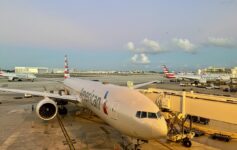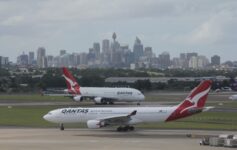More countries are re-opening their borders with an asterisk; visitors must demonstrate a negative COVID-19 test. Is this the new standard for international travel?
If you are considering booking travel or signing up for a new credit card please click here. Both support LiveAndLetsFly.com.
If you haven’t followed us on Facebook or Instagram, add us today.
More Countries Re-Open
Colombia and South Africa have announced they are re-opening for tourism. Thailand has a 31-step program that Gary Leff expertly outlined for visitors to stay in Thailand for up to 270 days. Barbados, Bermuda, and Croatia all welcome healthy Americans. They all require a recent negative COVID-19 test.
Countries have a need to re-open but also need to protect their citizens. A negative COVID-19 test allows for some basic level of assurance that visitors didn’t have the virus when they departed their country of origin. A negative test is, of course, not a sure thing but it goes a long way to provide a “safer” option without bankrupting their tourism-dependent economies.
United Has a Plan
For flights to Hawai’i, United plans to offer rapid COVID-19 tests at San Francisco International airport. While Hawai’i is clearly a domestic destination, it’s also an outlier due to its proximity to the mainland and limited health resources. The rapid tests allow United passengers to buy tickets to the islands without hassling with testing on their own.
And United has a great idea in theory.
One problem with the current process for visiting Croatia, for example, is the needed recency of test results. Results must be no older than 72 hours upon arrival. For passengers with connecting flights from the west coast, transit alone will eat 16 hours of that period. There is also an issue of when the labs report data and time zone differences between the origin and destination.
Rapid tests overcome those issues because travellers will receive a result in just minutes, right before they board. This is better for countries with restrictions because it’s entirely possible a traveller could contract the virus during the three days prior to their arrival, which may have been 5-7 days from when they took the test.
Is This Tenable?
Part of the issue with the test is availability. Rapid tests require a trained practitioner to administer the test which can be executed at single departure points for specific flights. Expansion of that program could be a challenge, from paperwork to space to hold those who need to be tested, have been tested, have been approved, need to be retested, or failed.
The cost is also prohibitive. United will charge $250 per test at the airport or $80 for a self-test mail-in option. Hawaiian Airlines has already entered into a “test war” with United offering the same rapid test but for just $150/person, slightly more for the mail-in test at $90.
At current airfares, this could be a viable option. For example, Puerto Rico also requires a negative COVID-19 test and airfares from Pittsburgh in October and November run just $140 roundtrip – the price is usually double or triple that. Adding in the cost of a home test still keeps the cost under normal prices. Bogota from Pittsburgh is just $192 with the same requirement for a negative test, add in the cost of a mail-in test and the total is still well under the normal cost of the trip.
However, when airfare prices begin to return, if they outpace the cost increases it could inhibit growth at a critical phase for those countries.
The Dominican Republic has an interesting alternative. Rather than requiring a negative test, no test is required prior to entry on October 1st. However, upon arrival, the country will randomly test visitors before granting entry. This could be a better option for countries eager to return tourism but without the issue of test result delays and costs.
Cathay Pacific of Hong Kong and IATA (travel industry group) is calling for the use of 15-minute rapid tests that retail for $10. It’s unclear from this article as to whether or not such an affordable test exists already or if it is more of a goal to obtain. If the test does cost just $10, it looks like United’s $250 price tag is really just another honeypot of ancillary revenue though I suspect their healthcare partner is adding staffing and processing costs to the equation.
Conclusion
The new standard for international travel appears to be a negative COVID-19 test result 72 hours prior to arrival. But for airlines, the new standard could be the facilitation of a rapid test. While the whole world would prefer to no longer test for COVID-19 at all, the question for airlines is whether offering the test can deliver results on the balance sheet.
What do you think? Is a negative COVID-19 test result the new international travel standard? Will airlines work these into their fares? When do you think the requirement will fade away?




If the airlines care about the return of international travel they will provide a testing option. For many travelers the certainty of having results will outweigh the costs. I canceled a trip to Tahiti earlier in the summer simply because I could not find a provider who could guarantee results in the timeframe required. NYC now has options for expedited results, but they are limited and a rush on testing could still cause unexpected delays. I imagine there are many places in the country where a result within 72 hours less travel time is just not possible. Surprising that the market is just now coming up with solutions for people who need a quick result and are willing to pay a premium.
I had been wanting to go to Hawaii but with Florida opening fully and not knowing if Hawaii will yet again push the date of re-opening without quarantine, I think I will spend time in the more reliable Florida. at least till next year or if I hear most things are open and have minimal hassle.
The problem with rapid testing is accuracy. Much higher rate of false positives/negatives. Let’s say the actual current asymptomatic infection rate is 1% (it’s actually much lower). Even only a 1% false positive rate means about half those that test positive are actually healthy. How do you charge someone $250 test fee, then deny them boarding and make them incur whatever expenses for trip cancellation, all on a test error? The false negatives are of course a bigger problem. I don’t know the current error rate of these tests, but I’ve been told by medical professionals that the rapid test error rates are considerably higher. Until that changes they aren’t a viable solution.
Had we an intelligent presidential administration, a huge priority could’ve been placed on the development of rapid, cheap tests. In combination with an approach to masks that wasn’t schizophrenic at best and contact tracing, we could be seeing a light at the end of the tunnel
I just hope eventually all this [redacted by admin] will end and things will return as they were once before as soon as COVID 19 vaccine comes out. Having to test for a virus in order to travel is just one of many things associated with all this madness and hysteria. Especially when we know by now that it is people with major health conditions and weakened immune systems that are most at risk. Also having to pay for the testing here adds insult to injury from all this hysteria [redacted by admin]!
All of this over nothing. GREAT FLU HOAX OF 2020 will go down as biggest mistake in human history. Media hit job on Trump and the rest of the world bought it. Masks
Are very dangerous as well not one study EVER proving they stop any virus. Ever !
Yes all those dead people are fake and you know more than tens of thousands of doctors around the world who are all perpetuating a hoax just for fun. Take your meds.
Guess what!
Deaths by the Flu and Influenza have all but disappeared. Who knew that Covid could cure those two, and instead be the cause of death.
What’s the point? If you’re presymptomatic, you might test negative. Maybe this catches a few people? Is it worth the expense/hassle/reduced travel?
The 10$ antigen and saliva tests do exist, Universities and sports leagues are using them to test daily. The problem is getting governments to accept them versus the PCR test which is more time consuming. Turkey can do 2 hour PCR tests for about 16$ but I strongly suspect there’s major government subsidies involved with that price.